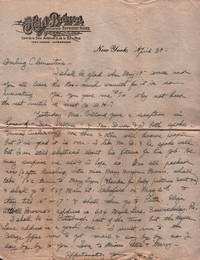Six 8 x 10 inch and smaller typed pages; one 4 x 5 inch card with two tickets; one twenty-six page 4 x 5.5 inch pamphlet; one si
1945 · Paris, France; and Washington, D.C.
by [Women's History - World War II – Women’s Army Corps – VE Day – Pacific Theater] Bremer, Mary J.; Miller, June; Melotte, John
Paris, France; and Washington, D.C., 1945. Six 8 x 10 inch and smaller typed pages; one 4 x 5 inch card with two tickets; one twenty-six page 4 x 5.5 inch pamphlet; one six page 6 x 8.5 inch pamphlet; six 2.5 x 3.5 photographs and two 3 x 4.5 inch photographs. Of the printed matter, most is affixed to paper, some small tears and folds; overall excellent; photographs near fine. Mary J. Bremer (1917–2019) was a Technician fourth grade from Grant Township, Nebraska. Her correspondents here include June Miller (1920–deceased), an aviation cadet from Michigan, and John Melotte (1919–deceased), an artilleryman from Philadelphia. Bremer and Miller were members
(truncated) of the Women’s Army Corps (WAC). Established in May of 1942 as the Women’s Army Auxiliary Corps, the WAC converted to active duty in July of 1943. The women of WAC, known as Wacs, served in noncombatant roles across the various theaters of World War II.
Offered here is a small archive of Bremer’s documents and photographs relating to WAC: a few letters, including a description of Paris the day after the Nazi surrender; two pamphlets, including the War Department pamphlet Two down and One to go –; and a collection of photographs of Eisenhower’s victory parade and Roosevelt’s funeral procession.
On April 12, 1945, President Roosevelt died of a stroke in Warm Springs, Georgia. His body was returned to Washington two days later, and a military procession escorted it from the train station to the White House. Two photographs of the funeral procession are included in the archive. One, showing a woman at the start of a section of the parade, is identified verso as “WACs led by Capt. Machen”.
The following month, the Nazis surrendered. Bremer’s friend June Miller was stationed in Paris at the time. She wrote to Bremer the next day, describing the celebration:
“It began the night before when we stood on the roof and watched the flares go off all over the city--just like the 4th of July; the Sacred Couer was blazing with lights and it looked like a miniature fairy-land. Last night all the famous old buildings, including the Arc d’Triumph, was all lit up, the fountains in the parks, at Concord, in front of the Trocadero--they were all going, and the kids were wading and splashing around, having the time of their life. It was really something to see--something the French had been waiting a long time for. “Fini le guerre”, they kept saying--the end of the war!”
Miller also claims to have witnessed a bomber flying a celebratory loop through the Eiffel Tower:
“When we came out of the [Trocadéro], the fountains were on, and what a sight that is. Looking down over the water that looks like a miniature waterfall to the Eiffel Tower at the bottom of a small hill. And if I hadn’t seen it with my own eyes, I would never have believed that I saw a small bomber come through the bottom, but that’s just what it did--and just did clear it, too. The planes seemed to be going as wild as the people on the ground--[they] were so thick up there that pretty soon we thought surely something would happen.”
In June, Dwight Eisenhower returned from Europe and a homecoming parade was held for him in Washington, D.C. Six photographs of this parade are included in the archive, including a shot of his plane arriving at the airport and one where he is visible standing in the back of a Jeep.
Miller notes in her letter from Paris that “you wondered what was coming next; where we would go from here, ‘cause in a sense, there is still a war very definitely going on”. In fact, John Melotte, who seems to be Miller’s partner, writes to Bremer that he “May be slated for that place they call the CBI, but don’t tell June please. She does not want me to even mention the place in my letters so I let well enough alone” (July 15, 1945). Hostilities would continue in the CBI—the China-Burma-India theater—until September of that year.
The process by which soldiers were selected to be sent to the Asia-Pacific theater is laid out in the War Department pamphlet Two down and One to go –. The pamphlet reminds them that there are still “a couple of big jobs ahead”, the primary one being to “crush” or “smash” the “Japs”, and the second one being to occupy and police “conquered lands [...] until the peril of future aggression is gone.” It is a visually striking piece, with illustrations in a bold black and red color palette; its cover is a reproduction of a caricature of Hitler, Mussolini, and Hirohito by Polish-Jewish artist Arthur Szyk.
Also included in the archive are a card from a friend with tickets to an American League baseball game; a humorous poem congratulating Wacs Ruth O.B. and Lenore I. Nier on new work assignments; and a Christmas 1945 WAC pamphlet with a dinner menu and list of WAC officers. The pamphlet assures the Wacs, with a note from Colonel Kenton Cooley, “Before another Christmas you all will have returned to civilian life and each of you will take with you my appreciation and my sincere admiration for a great job well done.”
Of interest to scholars of women’s history, especially in the military; and of the events leading up to the end of the Second World War.
(Inventory #: List2747)










![Exodus Is An Illumination Theatre of Madness An Laughter Poetry and Thieves to Steal Your Soul [Flyer for a Berkeley Performance by the San Francisco Mime Troupe and Others]](https://d3525k1ryd2155.cloudfront.net/h/479/906/1692906479.0.m.jpg)